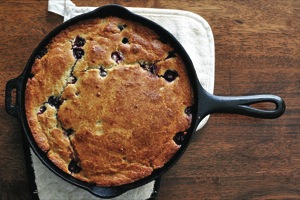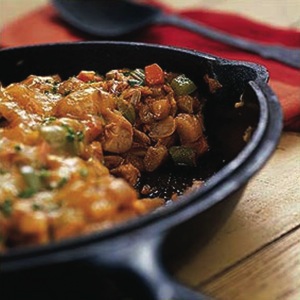
While shopping for a cast-iron skillet, I found myself looking for the thickest bottom with the lowest weight (seriously). I now use this as a joke with respect to boyfriend shopping and luckily have found both, a perfect skillet and a perfect man.
What struck me to go buy a cast-iron skillet? Maybe I was bored with my sauté pans or maybe I wanted to get back to basic, time-tested cookware. I definitely have enough pans in my kitchen and needed to assess the productivity this item would bestow. Looking at the many things that I could do with a cast-iron skillet, I was drawn by the overall usefulness of this kitchen tool.
Aside from its simple yet elegant aesthetic, the cast-iron skillet is a kitchen work horse and a (personal) piece of nostalgia. It can be used to create almost everything in the kitchen that would otherwise require multiple pieces of cookware; cornbread, soufflés, upside-down cakes, dumplings, seared meats and all things breakfast. The latter item is where the nostalgia kicks in; growing up on a farm in Massachusetts, almost all our breakfasts were prepared in a cast-iron skillet. First the bacon was cooked, rendering the fat that polymerizes with the metal surface, continually “seasoning” the pan. Then the eggs would be fried in the fat, spooning the residual grease over the top of the eggs so you did not have to flip them. It’s a wonder I did not grow up a fat kid.

Seasoning the pan is of much interest and importance to the maintenance and non-stick quality of the surface. Seasoning is nothing more than baking fat into the porous surface of the metal; creating a smooth coating that also prevents rust. This can be done by initially coating the pan with a thin layer of solid fat. I prefer bacon fat or lard, but Crisco will work too, bake the pan upside down in a 350° oven for one hour. Be sure to have your window open, and overhead fan on, because the process will create a little smoke.
Although purchased pre-seasoned and then seasoned again at home, food materials have still been mildly sticking to my pan. This will subside after more time spent cooking fatty foods, the use of oil and proper cleaning. After use, I use water and a scrub brush to remove the residual food stuffs. After every use and gentle cleaning, use a paper towel to rub the pan with a drizzle of olive oil and a pinch of coarse salt.
As mentioned before, when choosing a cast-iron skillet, you want to find one that has the thickest bottom but also the lowest weight. Although all are fairly heavy, one that is overly heavy can be cumbersome to a smaller cook when they need to swirl butter or even clean it. As for the bottom, the cast-iron skillet acts as an equilibrating liaison between the heat of the range and the food that you are cooking. The material itself conducts and holds heat, contributing an evenly heated work surface. The thicker the pan, the more heat it will hold, dropping fewer degrees in temperature when food is added I found a 12” Lodge Logic skillet at Crate and Barrel for $27.00 weighing in at 7.2 lbs with a bottom thickness of 5.5 millimeters.
With the greater amount of heat that the skillet will hold, it is important to adjust your cooking temperatures accordingly. This usually means using a lower heat for a longer time which will require a bit more patience. But any well seasoned veteran of the kitchen, like the cast-iron skillet, will persevere and withstand the test of time.










